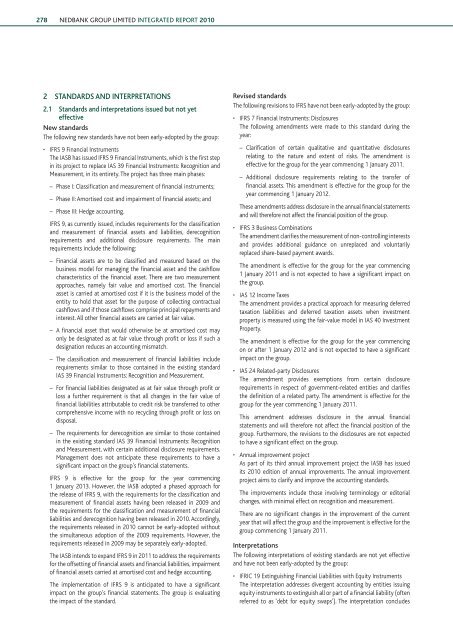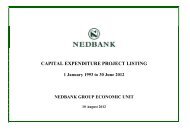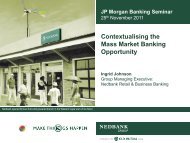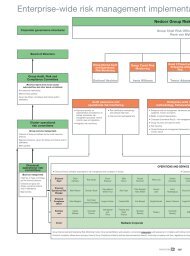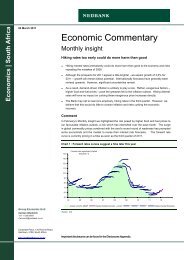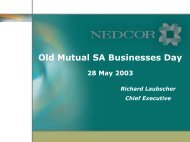Download the PDF (5.4 MB) - Nedbank Group Limited
Download the PDF (5.4 MB) - Nedbank Group Limited
Download the PDF (5.4 MB) - Nedbank Group Limited
Create successful ePaper yourself
Turn your PDF publications into a flip-book with our unique Google optimized e-Paper software.
278 NEDBANK GROUP <strong>Limited</strong> INTEGRATED REPORT 20102 Standards and interpretations2.1 Standards and interpretations issued but not yeteffectiveNew standardsThe following new standards have not been early-adopted by <strong>the</strong> group:• IFRS 9 Financial InstrumentsThe IASB has issued IFRS 9 Financial Instruments, which is <strong>the</strong> first stepin its project to replace IAS 39 Financial Instruments: Recognition andMeasurement, in its entirety. The project has three main phases:– Phase I: Classification and measurement of financial instruments;– Phase II: Amortised cost and impairment of financial assets; and– Phase III: Hedge accounting.IFRS 9, as currently issued, includes requirements for <strong>the</strong> classificationand measurement of financial assets and liabilities, derecognitionrequirements and additional disclosure requirements. The mainrequirements include <strong>the</strong> following:– Financial assets are to be classified and measured based on <strong>the</strong>business model for managing <strong>the</strong> financial asset and <strong>the</strong> cashflowcharacteristics of <strong>the</strong> financial asset. There are two measurementapproaches, namely fair value and amortised cost. The financialasset is carried at amortised cost if it is <strong>the</strong> business model of <strong>the</strong>entity to hold that asset for <strong>the</strong> purpose of collecting contractualcashflows and if those cashflows comprise principal repayments andinterest. All o<strong>the</strong>r financial assets are carried at fair value.– A financial asset that would o<strong>the</strong>rwise be at amortised cost mayonly be designated as at fair value through profit or loss if such adesignation reduces an accounting mismatch.– The classification and measurement of financial liabilities includerequirements similar to those contained in <strong>the</strong> existing standardIAS 39 Financial Instruments: Recognition and Measurement.– For financial liabilities designated as at fair value through profit orloss a fur<strong>the</strong>r requirement is that all changes in <strong>the</strong> fair value offinancial liabilities attributable to credit risk be transferred to o<strong>the</strong>rcomprehensive income with no recycling through profit or loss ondisposal.– The requirements for derecognition are similar to those containedin <strong>the</strong> existing standard IAS 39 Financial Instruments: Recognitionand Measurement, with certain additional disclosure requirements.Management does not anticipate <strong>the</strong>se requirements to have asignificant impact on <strong>the</strong> group’s financial statements.IFRS 9 is effective for <strong>the</strong> group for <strong>the</strong> year commencing1 January 2013. However, <strong>the</strong> IASB adopted a phased approach for<strong>the</strong> release of IFRS 9, with <strong>the</strong> requirements for <strong>the</strong> classification andmeasurement of financial assets having been released in 2009 and<strong>the</strong> requirements for <strong>the</strong> classification and measurement of financialliabilities and derecognition having been released in 2010. Accordingly,<strong>the</strong> requirements released in 2010 cannot be early-adopted without<strong>the</strong> simultaneous adoption of <strong>the</strong> 2009 requirements. However, <strong>the</strong>requirements released in 2009 may be separately early-adopted.The IASB intends to expand IFRS 9 in 2011 to address <strong>the</strong> requirementsfor <strong>the</strong> offsetting of financial assets and financial liabilities, impairmentof financial assets carried at amortised cost and hedge accounting.The implementation of IFRS 9 is anticipated to have a significantimpact on <strong>the</strong> group’s financial statements. The group is evaluating<strong>the</strong> impact of <strong>the</strong> standard.Revised standardsThe following revisions to IFRS have not been early-adopted by <strong>the</strong> group:• IFRS 7 Financial Instruments: DisclosuresThe following amendments were made to this standard during <strong>the</strong>year:– Clarification of certain qualitative and quantitative disclosuresrelating to <strong>the</strong> nature and extent of risks. The amendment iseffective for <strong>the</strong> group for <strong>the</strong> year commencing 1 January 2011.– Additional disclosure requirements relating to <strong>the</strong> transfer offinancial assets. This amendment is effective for <strong>the</strong> group for <strong>the</strong>year commencing 1 January 2012.These amendments address disclosure in <strong>the</strong> annual financial statementsand will <strong>the</strong>refore not affect <strong>the</strong> financial position of <strong>the</strong> group.• IFRS 3 Business CombinationsThe amendment clarifies <strong>the</strong> measurement of non-controlling interestsand provides additional guidance on unreplaced and voluntarilyreplaced share-based payment awards.The amendment is effective for <strong>the</strong> group for <strong>the</strong> year commencing1 January 2011 and is not expected to have a significant impact on<strong>the</strong> group.• IAS 12 Income TaxesThe amendment provides a practical approach for measuring deferredtaxation liabilities and deferred taxation assets when investmentproperty is measured using <strong>the</strong> fair-value model in IAS 40 InvestmentProperty.The amendment is effective for <strong>the</strong> group for <strong>the</strong> year commencingon or after 1 January 2012 and is not expected to have a significantimpact on <strong>the</strong> group.• IAS 24 Related-party DisclosuresThe amendment provides exemptions from certain disclosurerequirements in respect of government-related entities and clarifies<strong>the</strong> definition of a related party. The amendment is effective for <strong>the</strong>group for <strong>the</strong> year commencing 1 January 2011.This amendment addresses disclosure in <strong>the</strong> annual financialstatements and will <strong>the</strong>refore not affect <strong>the</strong> financial position of <strong>the</strong>group. Fur<strong>the</strong>rmore, <strong>the</strong> revisions to <strong>the</strong> disclosures are not expectedto have a significant effect on <strong>the</strong> group.• Annual improvement projectAs part of its third annual improvement project <strong>the</strong> IASB has issuedits 2010 edition of annual improvements. The annual improvementproject aims to clarify and improve <strong>the</strong> accounting standards.The improvements include those involving terminology or editorialchanges, with minimal effect on recognition and measurement.There are no significant changes in <strong>the</strong> improvement of <strong>the</strong> currentyear that will affect <strong>the</strong> group and <strong>the</strong> improvement is effective for <strong>the</strong>group commencing 1 January 2011.InterpretationsThe following interpretations of existing standards are not yet effectiveand have not been early-adopted by <strong>the</strong> group:• IFRIC 19 Extinguishing Financial Liabilities with Equity InstrumentsThe interpretation addresses divergent accounting by entities issuingequity instruments to extinguish all or part of a financial liability (oftenreferred to as ‘debt for equity swaps’). The interpretation concludes


